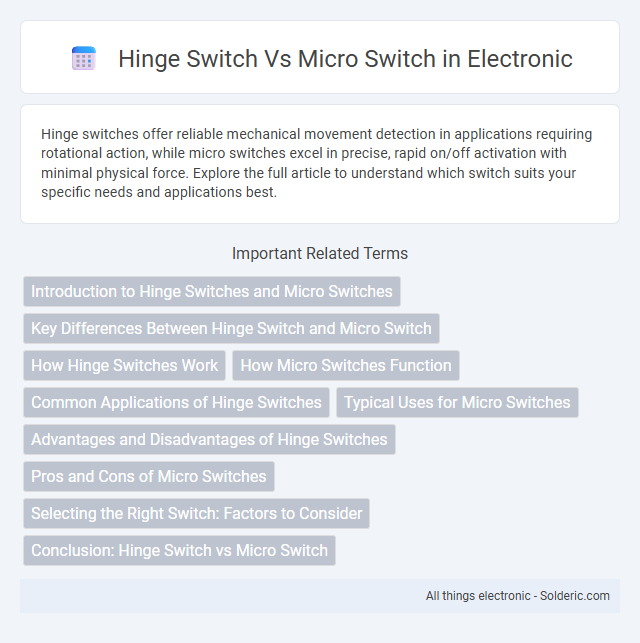Hinge switches offer reliable mechanical movement detection in applications requiring rotational action, while micro switches excel in precise, rapid on/off activation with minimal physical force. Explore the full article to understand which switch suits your specific needs and applications best.
Comparison Table
| Feature | Hinge Switch | Micro Switch |
|---|---|---|
| Definition | Switch activated by a hinge mechanism, typically for door or lid actuation. | Small, precise snap-action switch activated by minimal physical force. |
| Size | Larger, bulkier design to accommodate hinge movement. | Compact, miniature size suitable for tight spaces. |
| Actuation Mechanism | Mechanical hinge motion to trigger switch operation. | Snap-action lever or button for fast, reliable switching. |
| Typical Applications | Doors, lids, and covers in appliances and machinery. | Control panels, limit switches, and safety devices. |
| Durability | Moderate durability; depends on hinge quality. | High durability with long mechanical life cycles. |
| Switching Speed | Slower response tied to hinge movement speed. | Fast, precise operation due to snap-action design. |
| Operating Force | Higher force required to move the hinge and actuate. | Low actuation force needed. |
Introduction to Hinge Switches and Micro Switches
Hinge switches operate through a pivoting mechanism, allowing smooth toggling typically used in lid or door applications, while micro switches rely on a sensitive lever or button to detect precise movements or positions in electronic devices. Both types offer reliable switching solutions, but hinge switches excel in mechanical durability and micro switches provide rapid electrical response with high precision. Understanding the operational differences helps you choose the right switch type tailored to your specific control and automation needs.
Key Differences Between Hinge Switch and Micro Switch
Hinge switches and micro switches differ primarily in their design and application; hinge switches operate through a pivoting mechanism suitable for larger, slower movements, while micro switches utilize a snap-action mechanism for precise, rapid switching. Hinge switches are commonly found in applications like door mechanisms and appliances where space allows, whereas micro switches excel in industrial controls, safety devices, and limit switches requiring high accuracy and reliability. The durability and sensitivity of micro switches typically surpass hinge switches, making them ideal for high-frequency, low-force operations.
How Hinge Switches Work
Hinge switches operate by using a pivoting mechanism that opens or closes an electrical circuit when the hinged part moves, allowing precise control over device functions like doors or lids. Unlike micro switches, hinge switches are designed for applications requiring larger mechanical movement and provide a reliable tactile response. Your choice between a hinge switch and a micro switch should consider the required actuation angle and force sensitivity for optimal performance.
How Micro Switches Function
Micro switches function by utilizing a small internal spring mechanism that actuates the switch arm with minimal physical force, enabling precise and reliable electrical contact. This design allows micro switches to detect even subtle movements, making them ideal for safety controls, limit detection, and automation in various electronic devices. Your choice between hinge switch and micro switch hinges on the need for accuracy and responsiveness, with micro switches offering superior sensitivity and durability in complex applications.
Common Applications of Hinge Switches
Hinge switches are commonly used in door interlock systems, safety devices, and access control applications where detecting the open or closed position of a hinged component is critical. These switches provide reliable mechanical actuation ideal for appliances, industrial machinery, and security panels. Your choice of a hinge switch ensures precise monitoring of door or cover status in environments requiring safety interlocks or operational triggers.
Typical Uses for Micro Switches
Micro switches are commonly used in appliance controls, industrial machinery, and automotive systems due to their precise sensitivity and reliable switching action. These switches provide essential functions such as limit detection, safety interlocks, and position sensing in devices like microwave ovens, vending machines, and door interlocks. Their durability and quick response make them ideal for applications requiring consistent performance under repetitive operations.
Advantages and Disadvantages of Hinge Switches
Hinge switches offer the advantage of compact design, allowing for easy integration into devices with limited space and providing reliable mechanical operation with a straightforward on/off mechanism. However, their disadvantages include limited durability under high-frequency use and lower precision compared to micro switches, which can impact long-term performance in demanding environments. Hinge switches are typically cost-effective but may lack the sensitivity and consistency required for applications where exact switching thresholds are critical.
Pros and Cons of Micro Switches
Micro switches offer high reliability and durability with a precise clicking mechanism that ensures consistent performance in various applications, making them ideal for safety and control devices. However, they can be more expensive and bulky compared to hinge switches, limiting their use in compact designs. Your choice depends on the required sensitivity and space constraints, where micro switches provide superior accuracy and longevity but at a higher cost.
Selecting the Right Switch: Factors to Consider
Selecting the right switch between hinge switches and micro switches depends on factors such as application requirements, load capacity, and environmental conditions. Hinge switches are preferable for larger mechanical movements and higher durability in heavy-duty applications, while micro switches excel in precise, low-force actuation with rapid response times. Evaluating the required electrical rating, installation space, and mechanical stress ensures optimal switch performance and longevity.
Conclusion: Hinge Switch vs Micro Switch
Hinge switches provide robust durability and are ideal for applications requiring consistent mechanical movement, offering reliable performance with a simple pivot mechanism. Micro switches deliver high precision and rapid response, making them suitable for sensitive control systems where accuracy and small form factor are critical. Choosing between a hinge switch and a micro switch depends on the specific needs of durability versus precision in the intended application.
Hinge switch vs Micro switch Infographic

 solderic.com
solderic.com